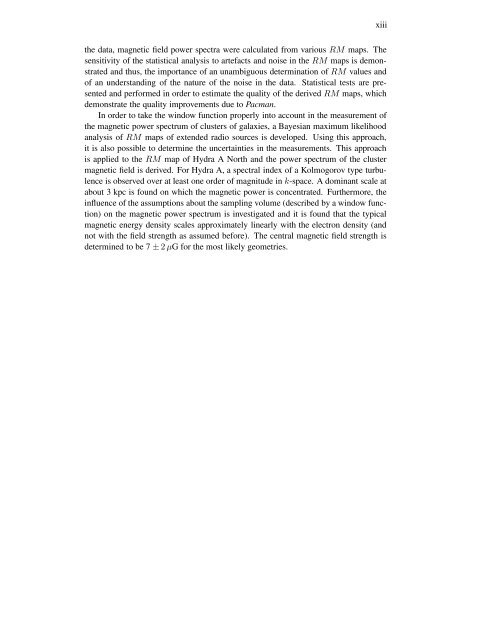Investigations of Faraday Rotation Maps of Extended Radio Sources ...
Investigations of Faraday Rotation Maps of Extended Radio Sources ...
Investigations of Faraday Rotation Maps of Extended Radio Sources ...
Create successful ePaper yourself
Turn your PDF publications into a flip-book with our unique Google optimized e-Paper software.
the data, magnetic field power spectra were calculated from various RM maps. The<br />
sensitivity <strong>of</strong> the statistical analysis to artefacts and noise in the RM maps is demonstrated<br />
and thus, the importance <strong>of</strong> an unambiguous determination <strong>of</strong> RM values and<br />
<strong>of</strong> an understanding <strong>of</strong> the nature <strong>of</strong> the noise in the data. Statistical tests are presented<br />
and performed in order to estimate the quality <strong>of</strong> the derived RM maps, which<br />
demonstrate the quality improvements due to Pacman.<br />
In order to take the window function properly into account in the measurement <strong>of</strong><br />
the magnetic power spectrum <strong>of</strong> clusters <strong>of</strong> galaxies, a Bayesian maximum likelihood<br />
analysis <strong>of</strong> RM maps <strong>of</strong> extended radio sources is developed. Using this approach,<br />
it is also possible to determine the uncertainties in the measurements. This approach<br />
is applied to the RM map <strong>of</strong> Hydra A North and the power spectrum <strong>of</strong> the cluster<br />
magnetic field is derived. For Hydra A, a spectral index <strong>of</strong> a Kolmogorov type turbulence<br />
is observed over at least one order <strong>of</strong> magnitude in k-space. A dominant scale at<br />
about 3 kpc is found on which the magnetic power is concentrated. Furthermore, the<br />
influence <strong>of</strong> the assumptions about the sampling volume (described by a window function)<br />
on the magnetic power spectrum is investigated and it is found that the typical<br />
magnetic energy density scales approximately linearly with the electron density (and<br />
not with the field strength as assumed before). The central magnetic field strength is<br />
determined to be 7 ± 2 µG for the most likely geometries.<br />
xiii
















